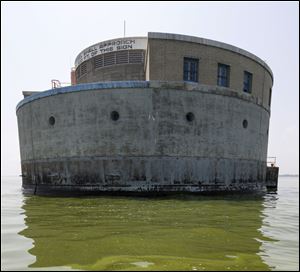
More must be done to protect Lake Erie
6/28/2018
Algae, an annual problem for northwest Ohio, is visible in Lake Erie near the Toledo water intake crib.
“Everybody agrees that more needs to be done,” State Rep. Mike Sheehy (D., Oregon), said earlier this week, regarding the Lake Erie pollution.
The problem is, while everyone may agree more needs to be done, more is not being done.
And algae continues to form on Lake Erie every summer. Soon it will be upon us again, threatening safe drinking water, fishing and tourism industries, economic development, and quality of life.
Click here to view more Blade editorials
On their way out the door for summer recess, lawmakers in Columbus did approve a bill sponsored by State Sen. Randy Gardner (R., Bowling Green) to devote more money to preventing pollution that fuels the algae.
The Clean Lake 2020 Plan calls for earmarking $2.65 million to the Ohio State Sea Grant and Stone Lab to research and monitor phosphorous loading, harmful algal growth, and toxicity levels; $10 million to research alternative uses for dredged sediment; up to $20 million in grants and loans to farmers in their efforts to reduce phosphorous runoff; and $3.5 million for soil and water conservation districts in the lake’s western basin.
Sen. Gardner called the measure a necessary step in saving the lake even though it does not include any mandates for farmers, limits on phosphorus releases, or penalties for those who would exceed those limits.
“If you don’t have mandates, you need to do this. And if you do have mandates, you still need to do this.”
The problem is that voluntary pollution-reduction measures for farmers — which Gov. John Kasich insisted for years were all that were necessary to save the lake — have not worked. At all.
Just weeks after relenting and declaring the western basin of the lake impaired under terms of the Clean Water Act, the Kasich administration released a report that shows that for the last five years voluntary efforts to reduce the pollution flowing into the Maumee River have had no measurable effect.
The Ohio Environmental Protection Agency’s own data shows that the Maumee watershed is by far the largest source of phosphorus and nitrogen going into Lake Erie. And about 90 percent of the phosphorus and nitrogen in the Maumee watershed come from non-point sources, which are mostly farms.
Yet, Mr. Gardner acknowledged that if his bill included any mandates or pollution limits for the state’s agricultural industry, it would have been doomed.
Ohio is making no progress whatsoever toward making its goal of reducing the phosphorus runoff 20 percent by 2020 and 40 percent by 2025. When Mr. Sheehy says that more needs to be done, he is making an almost comical understatement.
What everyone knows must be done, yet cannot find the political will to do, is to pursue the next logical step after declaring Lake Erie impaired. Like the Chesapeake Bay before it, Lake Erie will need a pollution inventory to track and quantify the sources of phosphorus, followed by a Total Maximum Daily Load, which is a pollution limit backed by the power of law.
Neither the Kasich administration nor the General Assembly seem to be able to take this step.
Federal Judge James Carr, who is presiding over a lawsuit regarding the matter, also could order state and federal authorities to begin the process of quantifying and limiting agricultural pollution when he revisits the case this fall.
Meanwhile, another summer of algae will go by. Toledo water customers will endure another season of nail-biting and hoping the city’s single water intake in the lake isn’t clogged by toxic algae that renders water undrinkable, as it did for three days in 2014.
Everyone agrees more must be done. And everyone knows what step comes next.
Gov. Kasich and his Ohio EPA have utterly failed to protect Lake Erie. The next governor of Ohio must be prepared to act — and act swiftly — to put in motion the pollution inventory, mandates for agriculture, and pollution limits that will finally rescue the lake.